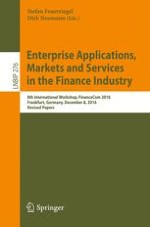2017 | Book
Enterprise Applications, Markets and Services in the Finance Industry
8th International Workshop, FinanceCom 2016, Frankfurt, Germany, December 8, 2016, Revised Papers
Editors: Stefan Feuerriegel, Dirk Neumann
Publisher: Springer International Publishing
Book Series : Lecture Notes in Business Information Processing
